Comprehensive Analysis of Management Principles and Practices
VerifiedAdded on 2023/01/09
|7
|1888
|89
Report
AI Summary
This journal article provides a comprehensive analysis of management within organizations, examining the roles of senior, middle, and junior-level managers and contrasting their responsibilities. It delves into different management styles, including autocratic, democratic, and laissez-faire approaches, evaluating their impact on employee engagement and organizational outcomes. The article further explores the reasons behind change in a business environment, analyzing change management approaches like the McKinsey 7 S model and Kotter's change management theory, and assessing the advantages and disadvantages of change for businesses, managers, and employees. Finally, it emphasizes the critical role of communication in decision-making and evaluates the nature and impact of management information systems on the decision-making process, highlighting their importance in providing timely and accurate data for informed business strategies. The article uses references to support the analysis and provides a detailed understanding of management principles and practices.
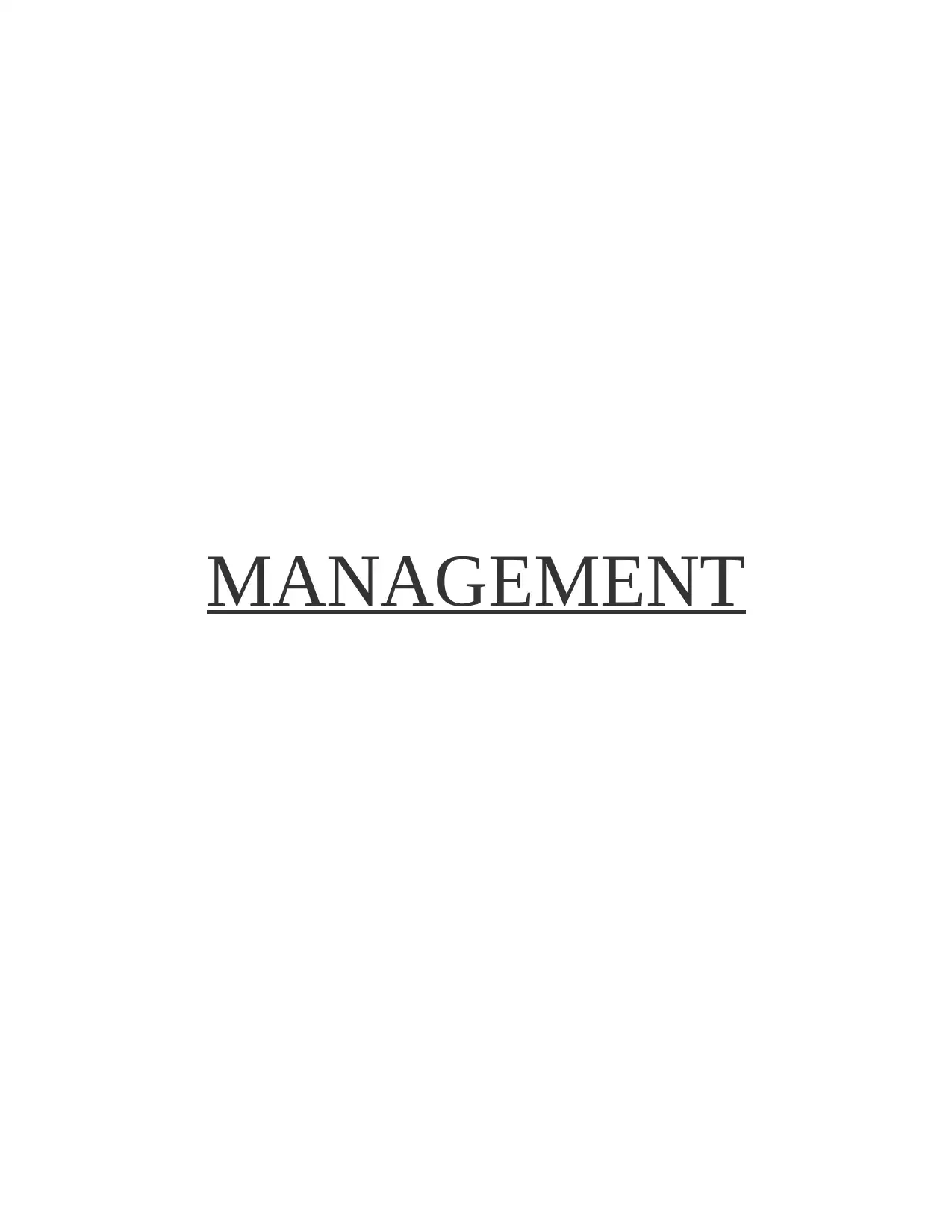
MANAGEMENT
Paraphrase This Document
Need a fresh take? Get an instant paraphrase of this document with our AI Paraphraser
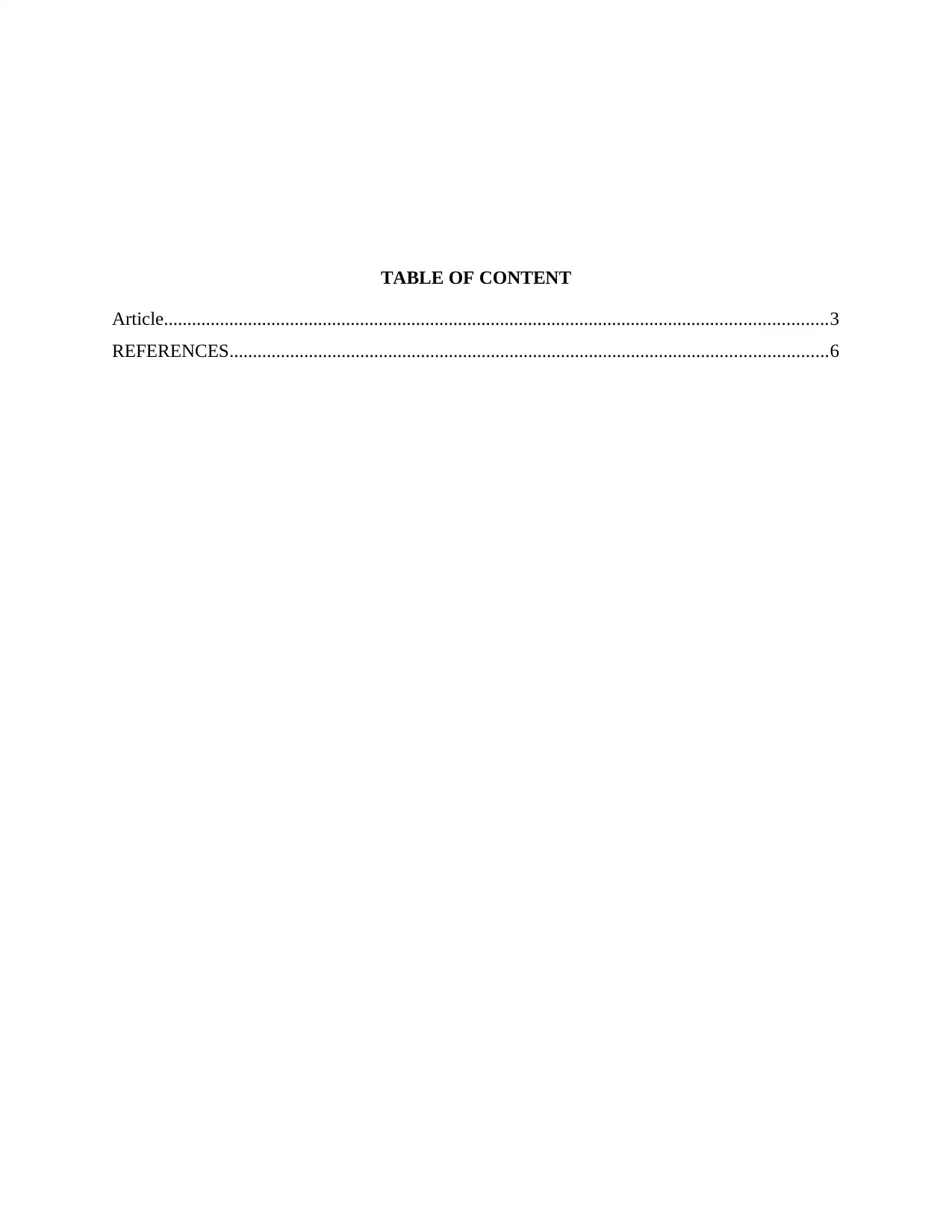
TABLE OF CONTENT
Article..............................................................................................................................................3
REFERENCES................................................................................................................................6
Article..............................................................................................................................................3
REFERENCES................................................................................................................................6
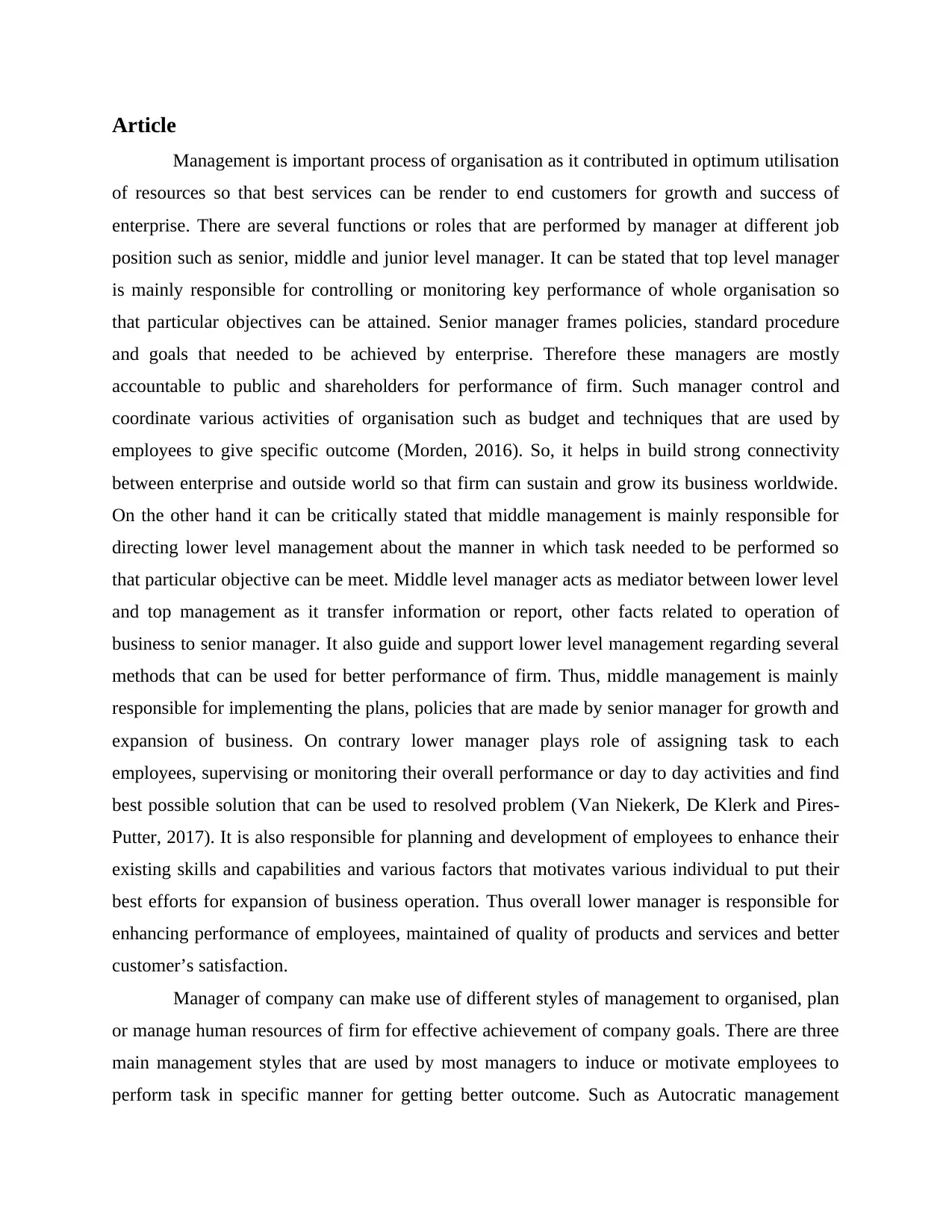
Article
Management is important process of organisation as it contributed in optimum utilisation
of resources so that best services can be render to end customers for growth and success of
enterprise. There are several functions or roles that are performed by manager at different job
position such as senior, middle and junior level manager. It can be stated that top level manager
is mainly responsible for controlling or monitoring key performance of whole organisation so
that particular objectives can be attained. Senior manager frames policies, standard procedure
and goals that needed to be achieved by enterprise. Therefore these managers are mostly
accountable to public and shareholders for performance of firm. Such manager control and
coordinate various activities of organisation such as budget and techniques that are used by
employees to give specific outcome (Morden, 2016). So, it helps in build strong connectivity
between enterprise and outside world so that firm can sustain and grow its business worldwide.
On the other hand it can be critically stated that middle management is mainly responsible for
directing lower level management about the manner in which task needed to be performed so
that particular objective can be meet. Middle level manager acts as mediator between lower level
and top management as it transfer information or report, other facts related to operation of
business to senior manager. It also guide and support lower level management regarding several
methods that can be used for better performance of firm. Thus, middle management is mainly
responsible for implementing the plans, policies that are made by senior manager for growth and
expansion of business. On contrary lower manager plays role of assigning task to each
employees, supervising or monitoring their overall performance or day to day activities and find
best possible solution that can be used to resolved problem (Van Niekerk, De Klerk and Pires-
Putter, 2017). It is also responsible for planning and development of employees to enhance their
existing skills and capabilities and various factors that motivates various individual to put their
best efforts for expansion of business operation. Thus overall lower manager is responsible for
enhancing performance of employees, maintained of quality of products and services and better
customer’s satisfaction.
Manager of company can make use of different styles of management to organised, plan
or manage human resources of firm for effective achievement of company goals. There are three
main management styles that are used by most managers to induce or motivate employees to
perform task in specific manner for getting better outcome. Such as Autocratic management
Management is important process of organisation as it contributed in optimum utilisation
of resources so that best services can be render to end customers for growth and success of
enterprise. There are several functions or roles that are performed by manager at different job
position such as senior, middle and junior level manager. It can be stated that top level manager
is mainly responsible for controlling or monitoring key performance of whole organisation so
that particular objectives can be attained. Senior manager frames policies, standard procedure
and goals that needed to be achieved by enterprise. Therefore these managers are mostly
accountable to public and shareholders for performance of firm. Such manager control and
coordinate various activities of organisation such as budget and techniques that are used by
employees to give specific outcome (Morden, 2016). So, it helps in build strong connectivity
between enterprise and outside world so that firm can sustain and grow its business worldwide.
On the other hand it can be critically stated that middle management is mainly responsible for
directing lower level management about the manner in which task needed to be performed so
that particular objective can be meet. Middle level manager acts as mediator between lower level
and top management as it transfer information or report, other facts related to operation of
business to senior manager. It also guide and support lower level management regarding several
methods that can be used for better performance of firm. Thus, middle management is mainly
responsible for implementing the plans, policies that are made by senior manager for growth and
expansion of business. On contrary lower manager plays role of assigning task to each
employees, supervising or monitoring their overall performance or day to day activities and find
best possible solution that can be used to resolved problem (Van Niekerk, De Klerk and Pires-
Putter, 2017). It is also responsible for planning and development of employees to enhance their
existing skills and capabilities and various factors that motivates various individual to put their
best efforts for expansion of business operation. Thus overall lower manager is responsible for
enhancing performance of employees, maintained of quality of products and services and better
customer’s satisfaction.
Manager of company can make use of different styles of management to organised, plan
or manage human resources of firm for effective achievement of company goals. There are three
main management styles that are used by most managers to induce or motivate employees to
perform task in specific manner for getting better outcome. Such as Autocratic management
⊘ This is a preview!⊘
Do you want full access?
Subscribe today to unlock all pages.

Trusted by 1+ million students worldwide
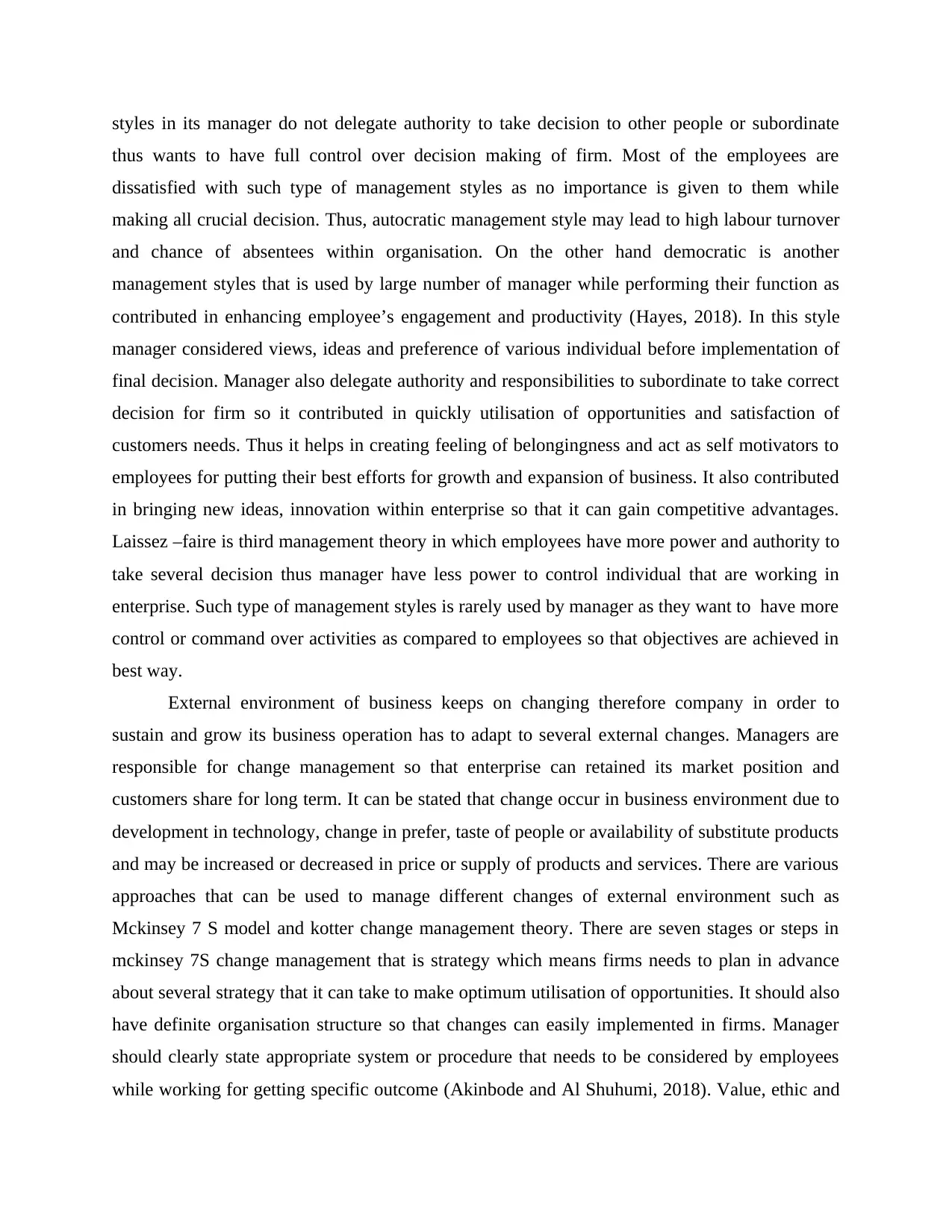
styles in its manager do not delegate authority to take decision to other people or subordinate
thus wants to have full control over decision making of firm. Most of the employees are
dissatisfied with such type of management styles as no importance is given to them while
making all crucial decision. Thus, autocratic management style may lead to high labour turnover
and chance of absentees within organisation. On the other hand democratic is another
management styles that is used by large number of manager while performing their function as
contributed in enhancing employee’s engagement and productivity (Hayes, 2018). In this style
manager considered views, ideas and preference of various individual before implementation of
final decision. Manager also delegate authority and responsibilities to subordinate to take correct
decision for firm so it contributed in quickly utilisation of opportunities and satisfaction of
customers needs. Thus it helps in creating feeling of belongingness and act as self motivators to
employees for putting their best efforts for growth and expansion of business. It also contributed
in bringing new ideas, innovation within enterprise so that it can gain competitive advantages.
Laissez –faire is third management theory in which employees have more power and authority to
take several decision thus manager have less power to control individual that are working in
enterprise. Such type of management styles is rarely used by manager as they want to have more
control or command over activities as compared to employees so that objectives are achieved in
best way.
External environment of business keeps on changing therefore company in order to
sustain and grow its business operation has to adapt to several external changes. Managers are
responsible for change management so that enterprise can retained its market position and
customers share for long term. It can be stated that change occur in business environment due to
development in technology, change in prefer, taste of people or availability of substitute products
and may be increased or decreased in price or supply of products and services. There are various
approaches that can be used to manage different changes of external environment such as
Mckinsey 7 S model and kotter change management theory. There are seven stages or steps in
mckinsey 7S change management that is strategy which means firms needs to plan in advance
about several strategy that it can take to make optimum utilisation of opportunities. It should also
have definite organisation structure so that changes can easily implemented in firms. Manager
should clearly state appropriate system or procedure that needs to be considered by employees
while working for getting specific outcome (Akinbode and Al Shuhumi, 2018). Value, ethic and
thus wants to have full control over decision making of firm. Most of the employees are
dissatisfied with such type of management styles as no importance is given to them while
making all crucial decision. Thus, autocratic management style may lead to high labour turnover
and chance of absentees within organisation. On the other hand democratic is another
management styles that is used by large number of manager while performing their function as
contributed in enhancing employee’s engagement and productivity (Hayes, 2018). In this style
manager considered views, ideas and preference of various individual before implementation of
final decision. Manager also delegate authority and responsibilities to subordinate to take correct
decision for firm so it contributed in quickly utilisation of opportunities and satisfaction of
customers needs. Thus it helps in creating feeling of belongingness and act as self motivators to
employees for putting their best efforts for growth and expansion of business. It also contributed
in bringing new ideas, innovation within enterprise so that it can gain competitive advantages.
Laissez –faire is third management theory in which employees have more power and authority to
take several decision thus manager have less power to control individual that are working in
enterprise. Such type of management styles is rarely used by manager as they want to have more
control or command over activities as compared to employees so that objectives are achieved in
best way.
External environment of business keeps on changing therefore company in order to
sustain and grow its business operation has to adapt to several external changes. Managers are
responsible for change management so that enterprise can retained its market position and
customers share for long term. It can be stated that change occur in business environment due to
development in technology, change in prefer, taste of people or availability of substitute products
and may be increased or decreased in price or supply of products and services. There are various
approaches that can be used to manage different changes of external environment such as
Mckinsey 7 S model and kotter change management theory. There are seven stages or steps in
mckinsey 7S change management that is strategy which means firms needs to plan in advance
about several strategy that it can take to make optimum utilisation of opportunities. It should also
have definite organisation structure so that changes can easily implemented in firms. Manager
should clearly state appropriate system or procedure that needs to be considered by employees
while working for getting specific outcome (Akinbode and Al Shuhumi, 2018). Value, ethic and
Paraphrase This Document
Need a fresh take? Get an instant paraphrase of this document with our AI Paraphraser
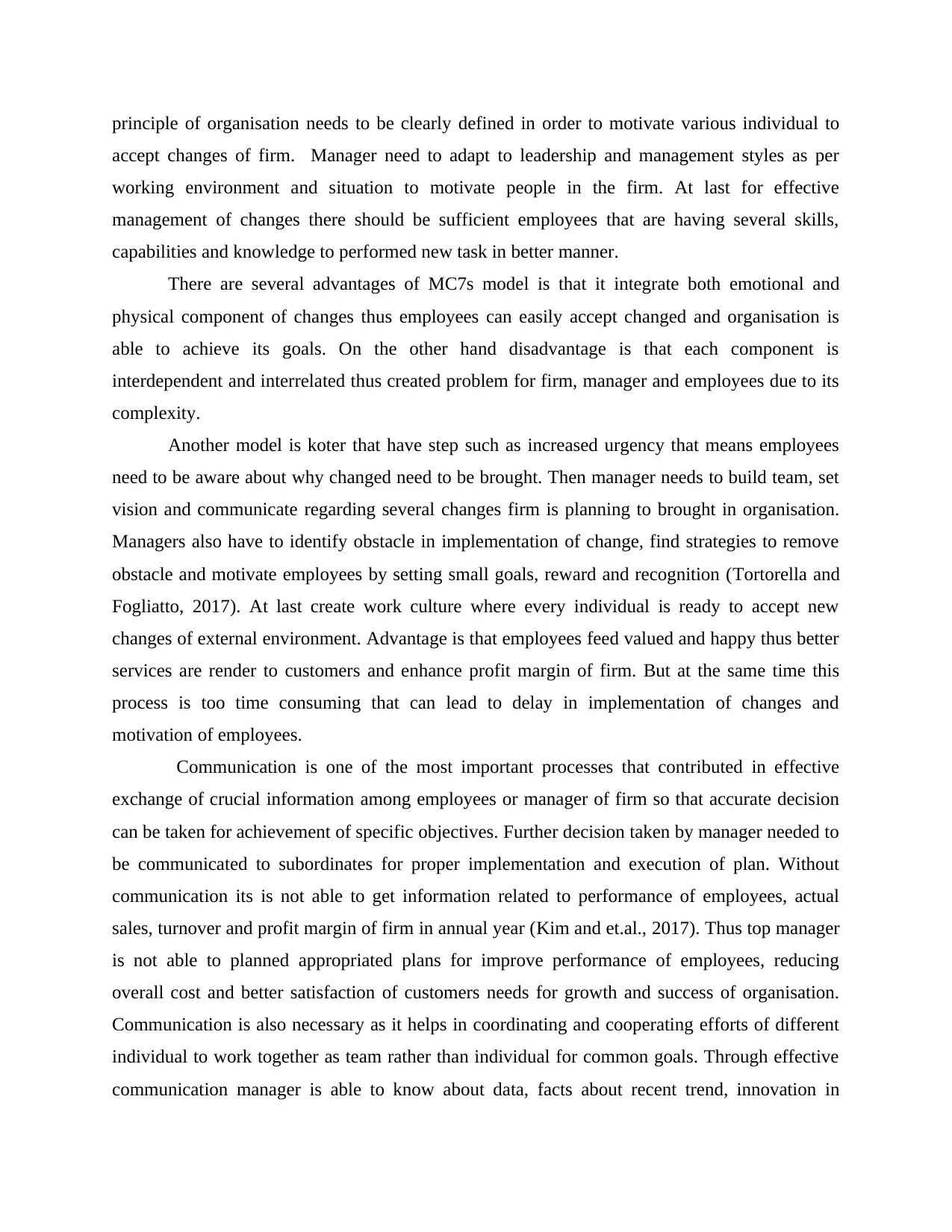
principle of organisation needs to be clearly defined in order to motivate various individual to
accept changes of firm. Manager need to adapt to leadership and management styles as per
working environment and situation to motivate people in the firm. At last for effective
management of changes there should be sufficient employees that are having several skills,
capabilities and knowledge to performed new task in better manner.
There are several advantages of MC7s model is that it integrate both emotional and
physical component of changes thus employees can easily accept changed and organisation is
able to achieve its goals. On the other hand disadvantage is that each component is
interdependent and interrelated thus created problem for firm, manager and employees due to its
complexity.
Another model is koter that have step such as increased urgency that means employees
need to be aware about why changed need to be brought. Then manager needs to build team, set
vision and communicate regarding several changes firm is planning to brought in organisation.
Managers also have to identify obstacle in implementation of change, find strategies to remove
obstacle and motivate employees by setting small goals, reward and recognition (Tortorella and
Fogliatto, 2017). At last create work culture where every individual is ready to accept new
changes of external environment. Advantage is that employees feed valued and happy thus better
services are render to customers and enhance profit margin of firm. But at the same time this
process is too time consuming that can lead to delay in implementation of changes and
motivation of employees.
Communication is one of the most important processes that contributed in effective
exchange of crucial information among employees or manager of firm so that accurate decision
can be taken for achievement of specific objectives. Further decision taken by manager needed to
be communicated to subordinates for proper implementation and execution of plan. Without
communication its is not able to get information related to performance of employees, actual
sales, turnover and profit margin of firm in annual year (Kim and et.al., 2017). Thus top manager
is not able to planned appropriated plans for improve performance of employees, reducing
overall cost and better satisfaction of customers needs for growth and success of organisation.
Communication is also necessary as it helps in coordinating and cooperating efforts of different
individual to work together as team rather than individual for common goals. Through effective
communication manager is able to know about data, facts about recent trend, innovation in
accept changes of firm. Manager need to adapt to leadership and management styles as per
working environment and situation to motivate people in the firm. At last for effective
management of changes there should be sufficient employees that are having several skills,
capabilities and knowledge to performed new task in better manner.
There are several advantages of MC7s model is that it integrate both emotional and
physical component of changes thus employees can easily accept changed and organisation is
able to achieve its goals. On the other hand disadvantage is that each component is
interdependent and interrelated thus created problem for firm, manager and employees due to its
complexity.
Another model is koter that have step such as increased urgency that means employees
need to be aware about why changed need to be brought. Then manager needs to build team, set
vision and communicate regarding several changes firm is planning to brought in organisation.
Managers also have to identify obstacle in implementation of change, find strategies to remove
obstacle and motivate employees by setting small goals, reward and recognition (Tortorella and
Fogliatto, 2017). At last create work culture where every individual is ready to accept new
changes of external environment. Advantage is that employees feed valued and happy thus better
services are render to customers and enhance profit margin of firm. But at the same time this
process is too time consuming that can lead to delay in implementation of changes and
motivation of employees.
Communication is one of the most important processes that contributed in effective
exchange of crucial information among employees or manager of firm so that accurate decision
can be taken for achievement of specific objectives. Further decision taken by manager needed to
be communicated to subordinates for proper implementation and execution of plan. Without
communication its is not able to get information related to performance of employees, actual
sales, turnover and profit margin of firm in annual year (Kim and et.al., 2017). Thus top manager
is not able to planned appropriated plans for improve performance of employees, reducing
overall cost and better satisfaction of customers needs for growth and success of organisation.
Communication is also necessary as it helps in coordinating and cooperating efforts of different
individual to work together as team rather than individual for common goals. Through effective
communication manager is able to know about data, facts about recent trend, innovation in
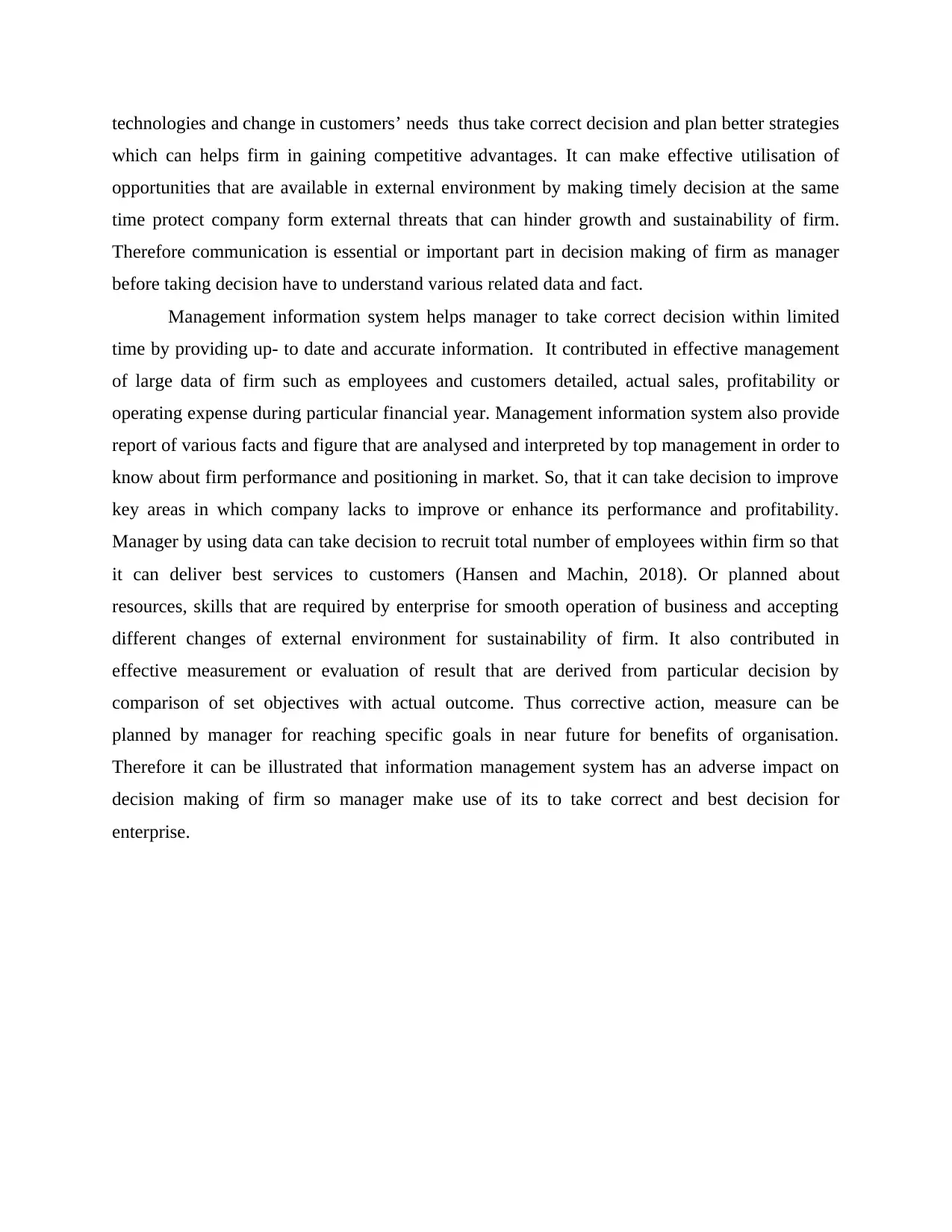
technologies and change in customers’ needs thus take correct decision and plan better strategies
which can helps firm in gaining competitive advantages. It can make effective utilisation of
opportunities that are available in external environment by making timely decision at the same
time protect company form external threats that can hinder growth and sustainability of firm.
Therefore communication is essential or important part in decision making of firm as manager
before taking decision have to understand various related data and fact.
Management information system helps manager to take correct decision within limited
time by providing up- to date and accurate information. It contributed in effective management
of large data of firm such as employees and customers detailed, actual sales, profitability or
operating expense during particular financial year. Management information system also provide
report of various facts and figure that are analysed and interpreted by top management in order to
know about firm performance and positioning in market. So, that it can take decision to improve
key areas in which company lacks to improve or enhance its performance and profitability.
Manager by using data can take decision to recruit total number of employees within firm so that
it can deliver best services to customers (Hansen and Machin, 2018). Or planned about
resources, skills that are required by enterprise for smooth operation of business and accepting
different changes of external environment for sustainability of firm. It also contributed in
effective measurement or evaluation of result that are derived from particular decision by
comparison of set objectives with actual outcome. Thus corrective action, measure can be
planned by manager for reaching specific goals in near future for benefits of organisation.
Therefore it can be illustrated that information management system has an adverse impact on
decision making of firm so manager make use of its to take correct and best decision for
enterprise.
which can helps firm in gaining competitive advantages. It can make effective utilisation of
opportunities that are available in external environment by making timely decision at the same
time protect company form external threats that can hinder growth and sustainability of firm.
Therefore communication is essential or important part in decision making of firm as manager
before taking decision have to understand various related data and fact.
Management information system helps manager to take correct decision within limited
time by providing up- to date and accurate information. It contributed in effective management
of large data of firm such as employees and customers detailed, actual sales, profitability or
operating expense during particular financial year. Management information system also provide
report of various facts and figure that are analysed and interpreted by top management in order to
know about firm performance and positioning in market. So, that it can take decision to improve
key areas in which company lacks to improve or enhance its performance and profitability.
Manager by using data can take decision to recruit total number of employees within firm so that
it can deliver best services to customers (Hansen and Machin, 2018). Or planned about
resources, skills that are required by enterprise for smooth operation of business and accepting
different changes of external environment for sustainability of firm. It also contributed in
effective measurement or evaluation of result that are derived from particular decision by
comparison of set objectives with actual outcome. Thus corrective action, measure can be
planned by manager for reaching specific goals in near future for benefits of organisation.
Therefore it can be illustrated that information management system has an adverse impact on
decision making of firm so manager make use of its to take correct and best decision for
enterprise.
⊘ This is a preview!⊘
Do you want full access?
Subscribe today to unlock all pages.

Trusted by 1+ million students worldwide
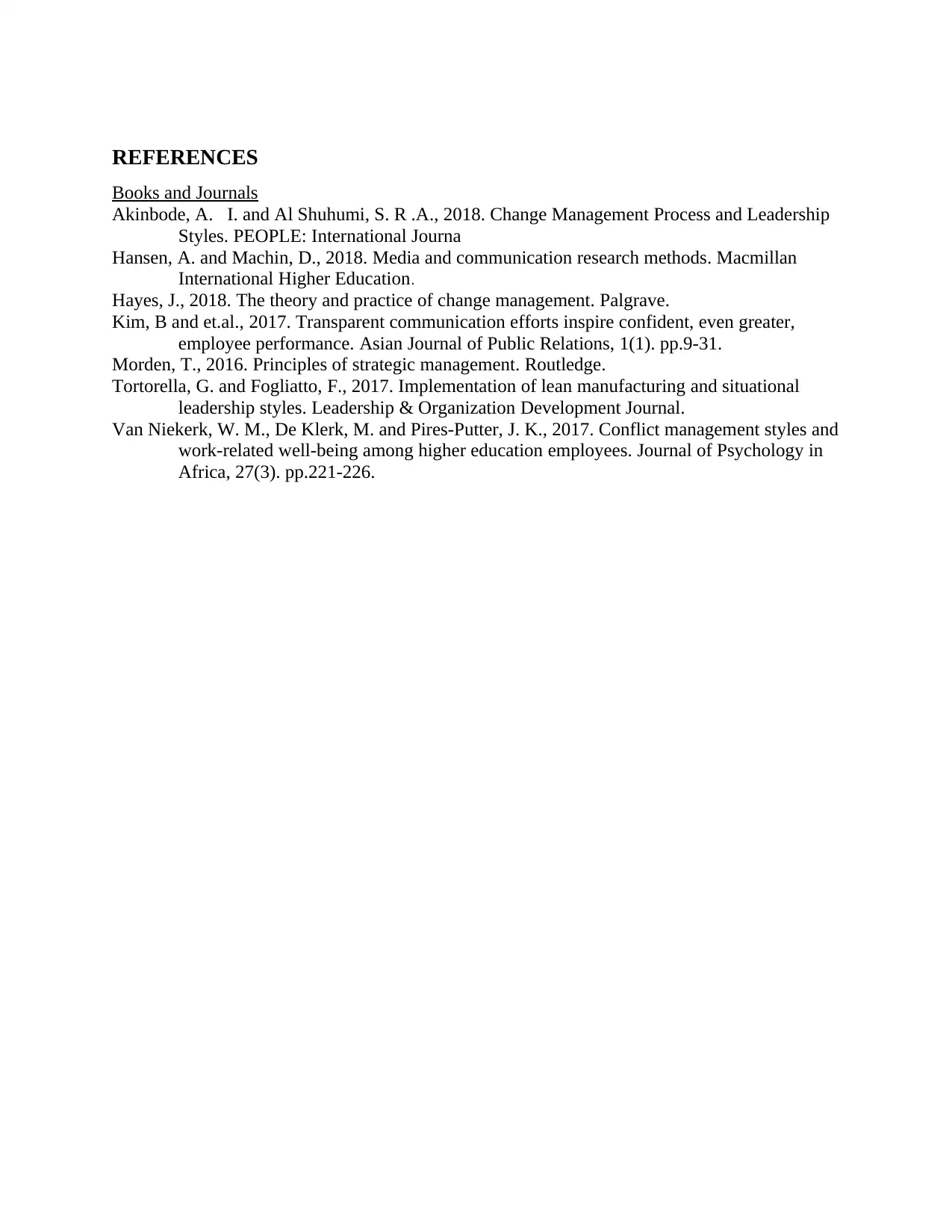
REFERENCES
Books and Journals
Akinbode, A. I. and Al Shuhumi, S. R .A., 2018. Change Management Process and Leadership
Styles. PEOPLE: International Journa
Hansen, A. and Machin, D., 2018. Media and communication research methods. Macmillan
International Higher Education.
Hayes, J., 2018. The theory and practice of change management. Palgrave.
Kim, B and et.al., 2017. Transparent communication efforts inspire confident, even greater,
employee performance. Asian Journal of Public Relations, 1(1). pp.9-31.
Morden, T., 2016. Principles of strategic management. Routledge.
Tortorella, G. and Fogliatto, F., 2017. Implementation of lean manufacturing and situational
leadership styles. Leadership & Organization Development Journal.
Van Niekerk, W. M., De Klerk, M. and Pires-Putter, J. K., 2017. Conflict management styles and
work-related well-being among higher education employees. Journal of Psychology in
Africa, 27(3). pp.221-226.
Books and Journals
Akinbode, A. I. and Al Shuhumi, S. R .A., 2018. Change Management Process and Leadership
Styles. PEOPLE: International Journa
Hansen, A. and Machin, D., 2018. Media and communication research methods. Macmillan
International Higher Education.
Hayes, J., 2018. The theory and practice of change management. Palgrave.
Kim, B and et.al., 2017. Transparent communication efforts inspire confident, even greater,
employee performance. Asian Journal of Public Relations, 1(1). pp.9-31.
Morden, T., 2016. Principles of strategic management. Routledge.
Tortorella, G. and Fogliatto, F., 2017. Implementation of lean manufacturing and situational
leadership styles. Leadership & Organization Development Journal.
Van Niekerk, W. M., De Klerk, M. and Pires-Putter, J. K., 2017. Conflict management styles and
work-related well-being among higher education employees. Journal of Psychology in
Africa, 27(3). pp.221-226.
1 out of 7
Related Documents
Your All-in-One AI-Powered Toolkit for Academic Success.
+13062052269
info@desklib.com
Available 24*7 on WhatsApp / Email
![[object Object]](/_next/static/media/star-bottom.7253800d.svg)
Unlock your academic potential
Copyright © 2020–2025 A2Z Services. All Rights Reserved. Developed and managed by ZUCOL.





